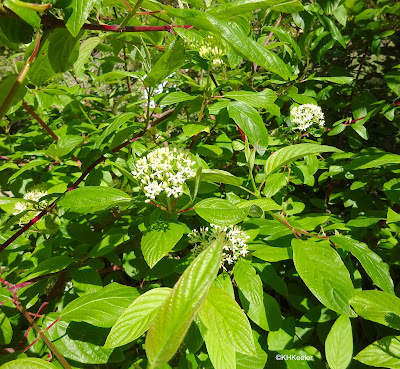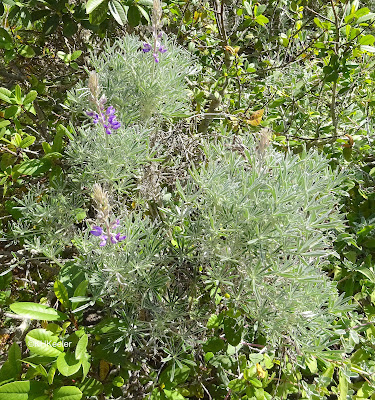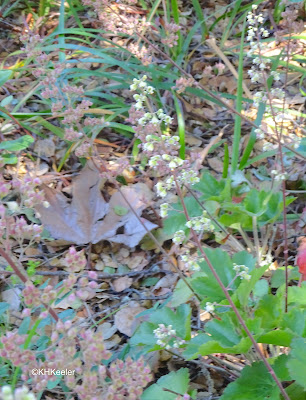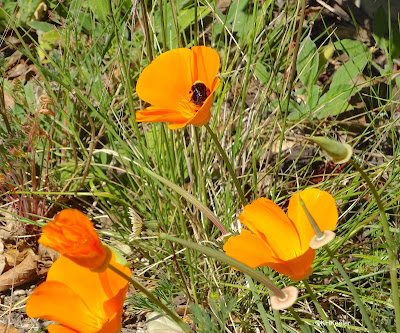The Pacific Grove Natural History Museum has a garden of native plants. In this post I share my photos from a visit in April. It meets two goals: a travel post and an affirmation that planting natives is not a hardship, you can have beautiful plants.
The first is the spectacular California flannel bush, Fremontidendron californicum (hibiscus family, Malvaceae). It is a native, fast-growing shrub (to 30'). The leaves and twigs are covered in a soft fuzz, the flannel. The scientific name honors J. C. Fremont (1813-1890) who explored California in the 1840s and took control of California for the United States in 1846. (See bios link). The plant is also commonly called fremontia, its former scientific name (Fremontidendron = Fremont-tree).
 |
| California flannel bush, Fremontidendron californicum |
Also native to central California is red twig dogwood, redosier dogwood, Cornus sericea (dogwood family, Cornaceae). It has a native range across all of northern North America. It is a lovely plant. The twigs are pretty in winter, the green leaves and white flowers attractive in summer.
 |
| redosier dogwood, Cornus sericea |
The garden also had a small California buckeye (
Aesculus californica, soapberry family, Sapindaceae). The tree is endemic to Calfornia. The leaves are shiny green, the flowers white and fragrant. (More on it
link). It has the largest seeds of any nontropical (temperate) plant. Leaves and fruit are toxic; don't eat them. The nectar is toxic to honeybees but apparently not to native bees and butterflies. (read more:
link,
link).
 |
| California buckeye, Aesculus californica |
Here's a closer look at the flowers. They are gorgeous and sweet-smelling; my photo doesn't do them justice.
 |
| California buckeye, Aesculus californica |
Also featured in the garden was this soft-looking lupine, which I think is longleaf bush lupine,
Lupinus longifolius (pea family, Fabaceae). However, Calscape (
link) lists 134 species of lupine native to California!...so its just a best guess. Very attractive.
 |
| California lupine |
For this next lupine, I don't even have a guess as to what species it is, but it too is handsome:
 |
| A different California lupine |
Note the California poppy...natives can make fine color combinations.
The Pacific Grove Natural History Museum had this big stand of California poppies (Eschsholzia californica, poppy family Papaveraceae). Everyone should grow their state flower!
 |
| California poppies (Eschscholzia californica) |
I have loved the Douglas iris (Iris douglasiana, iris family, Iridaceae) since I first went to California in 1975. Such a delight to encounter one in the forest! The Pacific Grove Museum garden had several, growing in deep shade.
 |
Douglas iris, Iris douglasiana
|
Also under the trees were these red sages, hummingbird sage (Salvia spathacea I think, mint family, Lamiaceae). There was a big flowering stalk which I never quite got the camera to capture (I blame the patches of sunlight) so here is the flower stalk in bud
 |
| Hummingbird sage, Salvia spathacea, flower stalk |
and here (below) are the flowers. The leaves in the photo below are from something else. See the long, soft, aromatic mint-like leaves in the photo above.
 |
| Flowers of hummingbird sage, Salvia spathacea |
This is the one I'd grow in an instant if it could live in my climate, California bee plant,
Scrophularia californica figwort family, Scrophulariaceae
). It is also called California figwort. Calscape calls it unassuming (
link). The Nature Collective says it could easily have come from a Dr. Seuss story (
link). I think the red flowers, well-designed for pollinator visits, are really cool. It attracts hummingbirds, and butterflies as well as bees.
 |
| California bee plant, Scrophularia californica |
There were many more natives with attractive flowers and leaves. Growing natives need not be a hardship.
 |
California wildflower; I don't know what it is.
alumroot, Heuchera maxima ?
|
I recommend visiting the Pacific Grove Museum of Natural History's garden!
One last photo: bumblebee in a California poppy:
Comments and corrections welcome.













No comments:
Post a Comment